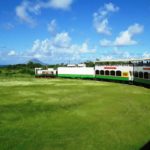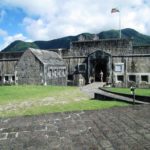A view of one of St. Kitts’ inviting beaches.
By Victor Block
The islands are about two miles and a 45-minute ferry boat ride apart. They share much of their history and a common government. For vacationers, both offer the attractions that lure people seeking sun, sand and relaxation on a Caribbean island. At the same time, St. Kitts and Nevis (pronounced Nee-vis) each has its own distinct personality. Neither island suffered much damage from the hurricanes that recently ravaged a number of other destinations in the region.
The islands were settled by the peaceful Awarak Indians and later by the more ferocious Caribs. Christopher Columbus sighted them during his second voyage to the New World in 1493. English and French settlers followed Columbus in the early 1600s, and established a lucrative sugar trade which spanned two centuries, and accounted for an influx of slaves from Africa. England eventually wound up in control of the islands, which achieved their independence in 1983.
Today, St. Kitts and Nevis comprise an island-nation within the British Commonwealth.
Given their history, traces of British influence are comingled with elements of African and indigenous cultures, providing a rich mosaic which touches many aspects of life.
Both islands are volcanic and overlooked by a dormant volcano, and each boasts beautiful sand beaches. Each also hosts populations of green vervet monkeys, which were introduced by French plantation owners some 300 years ago as pets for their families. These endearing little animals, which are named for their golden green fur, hang out in high elevations, peering inquisitively at intruders through the dense foliage.
The romance of the islands with sugar began around 1640 when its use to sweeten food, and produce rum and molasses, was increasing around the world. The rich volcanic soil and perfect climate prompted the proliferation of plantations which sprouted like the cane that they cultivated. At the height of the sugar era, St. Kitts was blanketed by some 200 plantations that grew cane.
But that heyday could not, and did not, last forever. Overplanting impoverished the soil, competition increased and external economic conditions brought an end to the peak time of sugar. While some cane still is grown and processed, tourism and light manufacturing are the basis of the economy today.
Visitors still may relive the heady days of sugar wealth by exploring the remains of plantations. Ruins of cone-shaped stone windmill towers, rusted steam-driven cane crushers and huge copper bowls in which the juice was boiled lie half-hidden in the vegetation.
A good way to recall the sugar plantation life is aboard the St. Kitts Scenic Railway, which offers a 30-mile, three-hour tour by train and bus along the northeastern coastline. In the past, the train delivered cane from plantations to the sugar factory in the capital city of Basseterre. Now passengers in double-deck cars enjoy views of the sea, pass through tiny villages, skirt lush rain forest terrain and spot long-abandoned windmills and chimneys of former estates.
For those lured by the promise of Caribbean-quality beaches, St. Kitts meets expectations. The best stretches of powdery white sand are concentrated along the southeastern peninsula. Most of those elsewhere consist of dark gray volcanic sand.
The choice of palm-lined beaches, combined with the multi-cultural history of St. Kitts, provide reasons enough to consider checking it out.
For more information about St. Kitts, visit stkittstourism.kn.
(Photos/submitted)














